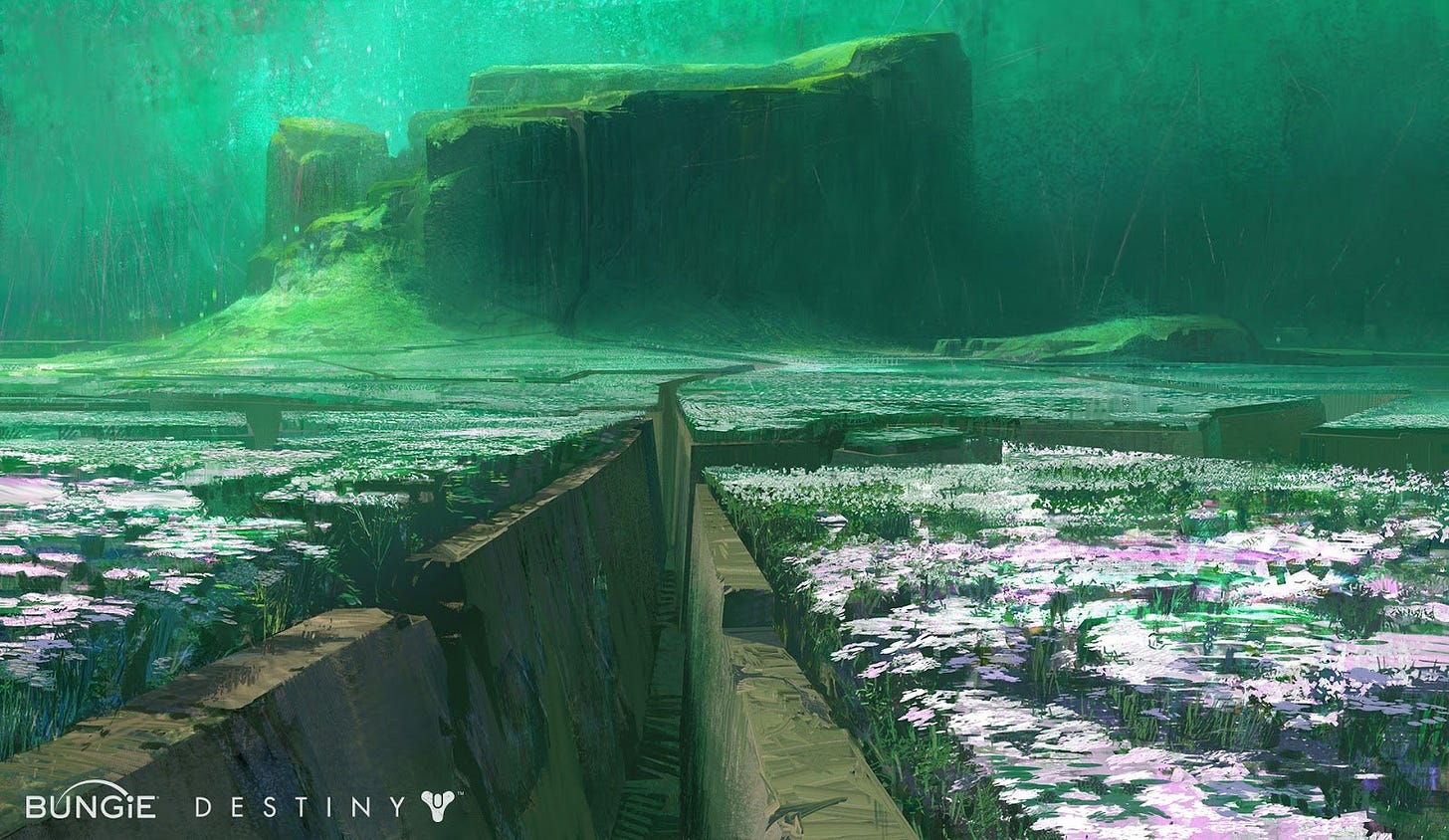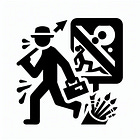How to Find Your Project Anchor
MipMap #008: As it turns out, something is more important than the blockout!
Roughly two years ago, I attempted to make a 3D scene inspired by this piece of concept art from Destiny 2:

The intricate trench network with the ominous structure in the background absolutely captivated me. Specifically, I love the contrast between the organic nature and atmosphere with the brooding background. It was a mood I wanted to recreate.
However, this was as far as I ever got in the project:
Stark difference, eh?
You might be able to pick up on the inspiration I took from the concept image. If you saw the scene file, you’d definitely be able to see what I was going for. I’d go into more detail about the scene, but upon reviewing it for this newsletter I think I might dust it off and see what I can do.
For now though, I’ll continue with what I was getting at.
There was one discernable issue I overlooked when blocking out my garden piece.
I didn’t respect my project anchor.
Throughout the project, my expectations rapidly exceeded what I had originally planned for. What was meant to showcase a cool ominous nature scene turned into a descent into Blender’s Geometry Nodes and LODs that ended up being quite out of my depth at the time. (Although to toot my own horn, after reviewing the nodes I think I was onto something.)
It’s worth noting that the render I shared above was what I still considered the blockout. Which I’ll also speak about as well.
Anchors Keep Your Vision Grounded
If you’re familiar with an anchor as used in the nautical world, their purpose is to keep a ship from drifting off with the waves. They prove quite handy whenever you want to do something other than actively keeping your ship in the right spot.
When I speak of anchors in terms of art and projects, the use is pretty similar.
Every single project needs an anchor; a reference point that shapes the scope and direction of your creative vision.
While a project anchor isn’t required to be a tangible item, it generally helps. Although it does depend on how you like to interpret and process information. If you can create based on emotions and feelings alone, then utilizing your anchor requires you to have a firm understanding of what those emotions mean to you.
I need tangibility though. For instance, my anchor with the above project was that concept image from Bungie. Had I been responsible, I would have kept that image in reach at all times. I didn’t though, which is why I ended up with some decent looking grass and untextured blocks.
Speaking of blocks, I spoke in the MipMap #002 about the importance of the blockout, laying out the project in a quick rough manner. It’s still vitally important. The more effort and intent you put into a project upfront, the better chance you have of succeeding and completing it.
What I didn’t have a good grasp of at the time of writing about the blockout was the role of the project anchor.
If we consider the blockout to be the most important step of forming your project, then we can consider the anchor to be the blockout for the blockout.
However, it’s worth keeping in mind that, just like a ship’s anchor, you can raise, move, and adjust your project’s anchor as many times as you’re comfrotable with.
You should never feel trapped by an anchor. If it’s ever feeling like you’re suffocating under one, just adjust it. Find another concept or piece to place your anchor upon.
Be wary of what results with the move though, you might find yourself thinking of a completely different project entirely when you shift anchors.
Is an Anchor Really Necessary?
For some people, it definitely is. I know I needed to outline the creative process that I use in order to understand what works and what doesn’t. Quantifying the steps and concepts is vital in order to understand what I can improve on in order to make good looking art.
If you’re on the fence about all of this processing, I don’t blame you. Regementing creativity is a dangerous process. Too much structure and you risk eliminating the inherent creativity that drives the whole process.
Consider the following though.
If you jump into a new project without understand what exactly is driving your process of creating, when do you know when to stop? What do you know that you’re creating?
I’d argue that more people utilize an anchor of some form than they realize. Sometimes its an overt reference piece, a book you read or a painting you saw. Other times its an emotion that you felt or a memory that deeply resonates.
Are you utilizing an anchor?
A simple way to find out is to identify what is driving you to create what you’re currently making. Like I mentioned, it doesn’t have to be a physical item or piece. As long as you can quantify it into something that you can understand it fulfills the role of the anchor.
Even better, try and go one step further. What inspired or allowed that first driving force to exist? Figuring out what is behind the thing you like is an infinitely more rewarding experience than trying to pull meaning from that singular thing.
To pull an example from an excellant video essay, the Cyberpunk genre was (and likely still is) defined by the aesthetics introduced in Ridley Scott’s 1982 film Blade Runner.
However, by distilling what Scott presented in Blade Runner down to it’s fundamental aspects you come to three major influences:
German Expressionism
A Rejection of Utopic Futurism
[80’s] Japan
By combining those three aspects, Ridley Scott was able to profoundly shape a visual aesthetic that is still loved and emulated forty years on from Blade Runner’s release.
Drop It, Pick It Up Again, Place It Somewhere Else
Say you did the above, you figured out the influences you liked, but its just not panning out like you envisioned. The blockout just isn’t coming together, or the words aren’t coming out, or the sketch isn’t manifesting.
First, identify what the issue is. You might be staring at a blank page, but there is something. It’s (usually) never a lack of creativity, there’s just something that is blocking the creative flow.
Maybe it’s similar to the issue I had with by garden project. You’ve fallen into figuring out the technicalities and slowly realized that the scope of what you wanted to do was completely out of your current reach.
Ask yourself whether you think you can adjust the scope to accomodate where your current skill is. This is never a comfortable question, since most of us are either too proud to admit we can’t do something or too meek to give ourselves the credit we deserve.
The unfortunate part is that I can’t give you a framework for your projects and your current skill. Where you sit and what you do is going to be entirely unique to each person reading this.
If you’ve been able to honestly assess where you currently are, you’ve either adjusted the scope of the project (congratulations! Get back to creating!), or now you’re sitting with the uncomfortable realization that you can’t do this particular endeavour. That’s okay.
Sometimes you’re imagination and aspirations get the better of you. It happens to everyone.
What you do next though, that’s the real defining moment.
Accepting that some projects can’t be done is the easy part. Now you have to figure out what to do with what you’ve already done for that binned project.
Depending on what exactly you’ve tried to do, there might be parts to salvage. Reuse props, repurpose blocks, upcycle aspects that you liked. Reusing existing assets is not only economical, but saves a ridiculous amount of time.
As I emphasized in MipMap #004, done is better than unfinished. It doesn’t have to be finished or perfect, you just have to clear the mental space that project took up. “Complete” is also an arbitrary goal that you yourself set. If you managed to establish what you wanted to do, you can just as easily adjust it to suit your current situation. No one (who you should actually listen to) will judge you for it.
The best part? Your anchors are completely project agnostic.
No one says you can only take inspiration from a thing once. I say that as long as you can keep finding new aspects or meanings to pull from something, keep milking it as long as you can.
So, identify and utilize your anchors.
They’ll help you when you don’t think anything else can.







H.R. Giger is another excellent artist worth checking out who surely inspired Ridley's designs on Blade Runner after their previous collaboration on Alien! (And after being brought into Hollywood by Jodorowsky for his killed Dune adaptation!) Definitely a fave of mine and an amazing portfolio for inspirations, especially for the use of scale and cyber-biology in his style